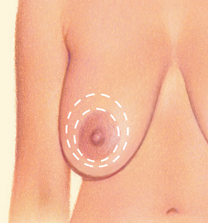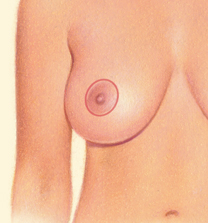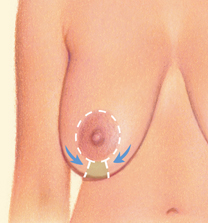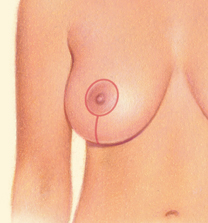- What Is Breast Lift Surgery?
- Breast Lift Candidates
- Breast Lift with Implants
- Is a Non-Surgical Breast Lift Possible?
- Breast Lift Consultation
- Preparing for Beast Lift Surgery
- Location of Your Breast Lift Procedure
- Anesthesia for Breast Lift Surgery
- Breast Lift Procedure
- Breast Lifting Risks
- After Breast Lift Surgery
- Breast Lift Recovery
- Breast Lift Results
- Breast Lift Scars
- Breast Lift Cost
“I would like to take this moment to recognize Dr. Zemmel and his staff at Richmond Aesthetic Surgery for my recent breast procedure. They have been awesome, amazing, extraordinary from start to finish…”
One of the most common cosmetic issues for which women seek treatment is to improve the shape of the breasts. Many women seek treatment from our plastic surgeon, Dr. Neil J. Zemmel, complaining of a loss of volume, loose skin, and sagging of the breasts. Many women presenting to Richmond Aesthetic Surgery desire a younger, more youthfully shaped breast, without significantly increasing the size of the breast, while other women desire both improvement in the shape and an increase in cup size. Many women wish to regain their pre-pregnancy shape and volume, while other women desire the fullness and shape found during pregnancy. Finally, other women may desire an even more enhanced shape and volume beyond what they have naturally experienced.
A number of factors can influence the volume and shape of the breasts over time. These include pregnancy and breast-feeding, age, sun exposure, and genetics. As the skin loses its elasticity over time, the breast begins to change shape. After pregnancy and breast-feeding and with advancing age, the amount of breast tissue will substantially decrease, causing the breast to lose volume. The breasts may then have a “deflated” or sagging appearance. Many women complain of excess, loose skin, and lowering of the nipple-areola on the surface of the breast. Many women complain of not being able to find properly fitting clothing and disproportion between the upper and lower body.
What Is Breast Lift Surgery?
Breast lifting (or mastopexy) is a surgical procedure designed to lift and reshape the breast. The goals for breast lifting are to tighten the skin of the breast, reshape the breast tissue and raise the position of the nipple and areola on the surface of the breast. Our surgeon performs a number of breast lifting procedures, and the technique used is dependent on the starting size, shape, and quality of breast tissue found.
If you’re considering a breast lift, with or without an implant, this page will explain the goals of the procedure, the types of breast lifting procedures, the recovery, and risks.
Am I a Candidate for Breast Lift Surgery?
The best candidates for a breast lift are those who are in generally good health and have realistic expectations about their surgical outcome. For patients who smoke, Dr. Zemmel requires them to quit at least 6 weeks before surgery and until 6 weeks after surgery, as to not interfere with the healing process.
Breast lift surgery is often desired by women following pregnancy and breastfeeding, as this can cause stretched skin and a decrease in breast volume. The procedure can also be beneficial for those who have undergone a major weight loss, which may have left their breasts looking deflated. This appearance is often caused by lost volume, not necessarily sagging of the breasts. Through a breast lift, this skin can be tightened and raised to a more youthful position on the chest wall, and the nipple and areola can be elevated as well as reduced in size. Dr. Zemmel is pleased to offer the lift procedure to women with virtually any size or shape of breasts.
While a breast lift is ideal for many women, those with smaller breasts who have experienced volume loss may benefit from breast implants alone, without the need for a lift. During your consultation, your surgeon will examine your physical state to determine the best treatment plan.
Do I Need a Breast Lift with Implants?
Often, many women present for breast lifting will be found to have very little breast and fatty tissue within the breast itself. These women may require placement of a breast implant in addition to a breast lift. The breast implant will not only restore additional volume to the breast, but serves as a foundation to the breast. Dr. Zemmel believes that in many cases breast lifting with an implant gives a longer-lasting, more cosmetically pleasing result than breast lifting alone.
Is a Breast Lift Without Surgery Possible?
Before considering breast lift surgery, many women seek non-surgical methods of lifting their breasts. Unfortunately, most non-surgical breast lift options only treat the skin and provide minimal lifting, if any. Whereas, the cause of breast drooping is typically stretched, lax tissue fibers and ligaments. In addition, many people believe that exercising the chest muscles will provide a breast lift, but just like other non-surgical methods, this will not tighten the lax or excess tissue that is leading to the drooping. Although there continue to be many advancements in the area of non-surgical cosmetic enhancement, at this point the most effective solution for sagging breasts is surgical intervention. During breast lift surgery, the lax tissue can be tightened, and excess skin can also be removed to provide the best possible outcome.
What Does the Breast Lift Consultation Involve?
During your consultation, both you and your surgeon will discuss your goals and desires regarding your procedure. Dr. Zemmel wants to know you as a person and want to have an honest dialogue throughout your entire treatment course. He wants to know exactly what your goals are with surgery, so he may meet and possibly exceed your expectations.
During the consultation, your surgeon will review your complete medical and surgical history, any medications you may take, any allergies, and whether you smoke. They also need to know when your last mammogram took place (if any) and whether you or any member of your immediate family has had problems or illnesses with the breasts. They will then perform a full breast exam, focusing on the factors pertinent to breast lifting:
- The overall size and shape of your breasts
- The quality of your skin and the presence of stretch marks
- The amount, quality, and distribution of breast and fatty tissue
- The shape and symmetry of your breast bone and rib cage
- The size, shape, and location of your nipple and areola
- The size, location, and symmetry of the crease beneath your breasts
- The proportions of your upper and lower body
- Your height, weight, and cup size
- The presence of any cysts, lumps, or masses
Your surgeon can answer more specific questions during your initial consultation, since a lot depends on your individual circumstances. Please be sure to ask them if there is anything about the procedure you don’t understand. While no surgery can permanently delay the effects of gravity, mastopexy can “set back the clock” giving a long-lasting result.
How Should I Prepare for Breast Lift Surgery?
During your initial consultation, it’s important to discuss your goals, desires, and expectations honestly with your surgeon. They will get to know you as an individual. They will examine your breasts and measure them while you’re standing. They will evaluate the overall contour and shape of your breasts, the position on the chest wall, and the elasticity of your skin. The shape of your chest, rib cage, and spine will also be evaluated, as well as the distribution of breast tissue, shape and size of the nipple and areola, and position of the creases of the breast.
You will be given a detailed operative plan for your breast lift. Your surgeon will discuss what is possible and what is not h your surgery. They will give you a very realistic idea of what can be accomplished with your surgery to meet your expectations. You will discuss your new breast shape and position, new cup size, the overall shape and contour, and the position of the nipple and areola.
Your surgeon will also discuss whether an implant is also necessary to give you the best outcome. They will go over all implant-related issues, and you will try on a number of implants to fit the proper size.
The technical aspects of your procedure will be discussed in full detail, including its risks and limitations, and your surgeon will make sure you understand the proposed incision pattern. They will make every effort to minimize your final scar. They will also explain the anesthesia to be used, the type of facility where the surgery will be performed, and the costs involved.
Don’t hesitate to ask your surgeon any questions you may have, especially those regarding your concerns and expectations about your final results.
Depending on your age and family history, you may be required to have a mammogram (breast x-ray) before surgery. Our surgeon asks for mammograms on all women over the age of 40. They may also require you to obtain routine blood work before surgery. You will also be given specific instructions on how to prepare for surgery, including guidelines on eating and drinking, smoking, and taking or avoiding certain vitamins and medications.
While you’re making preparations, be sure to arrange for someone to drive you home after your surgery and to help you out for a few days if needed.
I love Dr. Zemmel, my breasts look amazing.
Dr. Zemmel makes you feel comfortable and his staff is amazing….Manika Crews
July 03, 2018
Where Will My Breast Lift Procedure Be Performed?
Your breast lift surgery (mastopexy) will be performed by Dr. Zemmel at either Bon Secours St. Francis Hospital in Midlothian, Virginia, or in Bon Secours St. Mary’s Hospital in Richmond. He performs all of his surgeries in the hospital setting. He believes this gives patients the highest level of patient safety and improves outcomes. Dr. Zemmel has the full resources of the hospital available if needed. The operating rooms at both St. Francis and St. Mary’s are certified by The Joint Commission and, therefore, meet the highest level of safety standards. Breast lift surgery with or without an implant is typically performed on an outpatient basis. If your are undergoing a combination of procedures, such as a tummy tuck or liposuction with your breast lift, then our surgeon usually requires you to spend the night in the hospital.
What Type of Anesthesia Will I Have for Breast Lift Surgery?
Dr. Zemmel performs breast lift surgery under deep sedation or general anesthesia. The type of anesthesia used is usually determined by the anesthesia provider. Regardless of the type of anesthesia, you will be completely asleep during surgery, comfortable and totally unaware of the surgery. After surgery you will be transferred to the recovery room for 1 to 2 hours. There you will be made comfortable by the nurses and prepared for your discharge home.
How Is the Breast Lift Procedure Performed?
Mastopexy is typically performed in one to two hours, depending on the technique used. If breast implants are placed, an additional 45 minutes are needed.
Dr. Zemmel uses four different techniques, depending on the power of the lift required. A smaller amount of excess skin and a nipple/areola placed relatively higher on the breast will require a smaller lift. For those women with a significant amount of excess skin and nipple areola that is placed lower on the breast, a full lift maybe be needed. The appropriate technique will be determined prior to surgery based on what will give you the best overall shape and contour. The incision pattern dictates how much excess skin will be removed and allows your surgeon access to the deeper tissue of the breast for reshaping.
The types of lifts are as follows:
- Crescent Breast Lift: Those who need minimal lifting of the areola may be the best candidates for a crescent mastopexy. This technique removes a small, moon-shaped section of skin above the areola. When this is closed, the areola is subsequently moved higher on the breast. This type of lift utilizes a small incision at the top border of the areola that is well-disguised and heals well.
- Periareolar Breast Lift: This is also referred to as a doughnut mastopexy, concentric mastopexy, or Benelli Mastopexy. Dr. Zemmel performs this technique with the addition of an implant. The periareolar mastopexy can effectively tighten loose skin while reducing the areolar size. It is carried out as a circular incision is created around the border of the areola. A doughnut-shaped area of skin is then removed and the incision is closed, hiding potential scarring around the border of the areola.


- Vertical Breast Lift: A vertical mastopexy, or full-anchor pattern incision, is ideal for those who have a greater amount of excess skin and sagging than can be properly addressed with the above techniques. This procedure involves an incision that completely traces the areolar border and includes a vertical, downward incision, creating a “lollipop” shape. The anchor pattern may also require a horizontal incision in the inframammary crease below the breast.


- Full Mastopexy: A full mastopexy is recommended when the amount of excess skin and the areola position cannot be effectively lifted utilizing a different technique. With a full lift, the incision is made around the areola, vertically above the areola, and within the breast’s natural fold. This “anchor” pattern has the shape of an upside down “T”. Although it utilizes the largest incision, scarring is well-concealed and tends to heal nicely. In our surgeon’s experience, patients will always accept a full lift incision pattern for the benefit of improved shape.


As a general principle in breast lifting, the more excess breast skin, and the lower the nipple areola is found on the front of the breast, the greater the lift required to give good shape. Our surgeon believes that nearly all patients will accept a somewhat longer scar for the benefit of improved shape.
If a breast implant is placed with your breast lift, the same incision will be used. The implant will be placed in a pocket directly under the breast tissue, or deeper, under the muscle of the chest wall.
Dr. Zemmel closes all the incisions with fine absorbable sutures that give an excellent cosmetic result and do not need to be removed.
Dr. Zemmel goes into great detail to advise you on what technique will given you the best results as well as the pros and cons of each.
What Are the Risks of Breast Lift Surgery?
A breast lift (mastopexy) is a complex breast operation that should be performed by a qualified plastic surgeon. While the magnitude of a breast lift surgery of less than a cardiac or abdominal operation for example, breast lifting has risks that must be addressed. Our surgeon will do everything in their power to provide you with the safest, most reliable procedure with the best outcome. He accomplishes this through a number of ways:
- Performs all surgery in the hospital setting and uses only operating rooms with the highest level of safety accreditation.
- Performs surgery with Board Certified Anesthesiologists and Board Certified Nurse Anesthetists to ensure the safest anesthesia.
- Performs surgery with the same operating room team in order to maintain consistency with each procedure.
- Uses the highest quality materials and instruments when performing your procedure.
- Follows his patients very closely after surgery to ensure the smoothest and easiest recovery for their patients.
With any surgery, however, there is always a small possibility of complications or a reaction to the anesthesia. Bleeding and infection following a breast lift are extremely uncommon and occur less than 1% of the time. You incisions can widen to form thickened scars or you may have some asymmetry between the bests. You can reduce your risks by closely following your surgeon’s advice before surgery and postoperatively. They will discuss all of the risks and potential complications during your initial and pre-operative appointments.
What Can I Expect After Breast Lift Surgery?
After surgery you will be transferred to the recovery unit until you fully awaken and are made comfortable. From there you will be transferred back to your room in pre-operative holding, and discharged home. If you have undergone a combination procedure such as a “Mommy Makeover” you will be transferred to your room on the surgical floor.
You will awaken from surgery wearing a soft surgical bra similar to a sports bra. You will wear this for several weeks after surgery. You will see your surgeon one to three days after surgery for you first postoperative appointment. You will be given instructions before hospital discharge detailing how to care for your bandages, your pain medicine regimen, when to shower, and your activity level. You will receive an instruction packet at your pre-operative visit and your surgeon will go over these in person before discharge.
Expect your breasts to feel tight, swollen and slightly bruised. Many patients report that having a breast lift feels like having their breasts engorged with milk during breast-feeding. The discomfort is very tolerable and easily controlled with analgesics prescribed by your surgeon. The discomfort usually begins to resolve 3 to 5 days after surgery. At the first postoperative office visit, your bandages and surgical bra will be replaced by a soft sports bra. Depending on your progress, your surgeon will slowly increase your activity level over the next few weeks.
You will be seen frequently after surgery. Your first appointment after surgery usually occurs within one to three days. You will then see your plastic surgeon and their team every 5 to 7 days for approximately one month to closely monitor your progress.
At no time during your recovery will you feel “alone.” Dr. Zemmel and his team are always available to see you in the office or speak with you by phone to address any issues and concerns. Dr. Zemmel believes that meticulous postoperative care of their patients significantly improves outcomes and patient satisfaction.
What Does the Breast Lift Recovery Entail?
Healing from any surgical procedure is a gradual process and every one of Dr. Zemmel’s patients progresses at a slightly different rate. For smaller breast lifts, such as a crescent breast lift or a periareolar breast lift, the recovery time may be a few days. A full breast lift (Mastopexy) with breast implants may require eight to twelve days for recovery. Your surgeon will be there every step of the way to guide you through the recovery process. They will monitor your pain levels and assess the progress of any swelling or post-operative bruising. As your post-operative discomfort resolves and your incisions heal, your activity level will gradually be increased. In general most patients are able to return to work within 3 to 5 days for a smaller breast enhancement procedure, while the larger procedures may require 5 to 7 days.
You will be recommended to temporarily discontinue any heavy exercise or physical activity for several weeks after surgery. Our surgeon will usually allow light cardio activity 2 weeks after surgery, full cardio activity 3 weeks after surgery, and light weights 4 weeks after surgery.
When Will I See My Breast Lift Results?
The healing process takes anywhere from 6 to 18 months to complete. During this time you will notice an evolution of your results. Your scars will soften, fade, and blend in to the natural contours of your breasts. They will gradually become less obvious, and most of the time they eventually fade to thin white lines. The scars can usually be placed so that you can wear even low-cut tops without showing evidence of your procedure. Your breasts will soften and appear more natural. Your results will last for many years and you will enjoy your new look for the rest of your life.
What Will My Breast Lift Scars Look Like?
Long term the scars of all breast lifts (periareolar, vertical, and full mastopexy) heal very well. Our board-certified plastic surgeon will make every effort to minimize scarring with accurate technique in surgery as well as meticulous postoperative care. Approximately 2 weeks after surgery, patients will be placed on a regime of scar treatment. Six to twelve months after surgery many patients have very light, soft scars that blend into the surrounding breast contours. The scars are generally very well tolerated by most women and are hidden under clothing and bikini tops.
How Much Does a Breast Lift Cost?
Breast lift surgery typically costs approximately $8,000-$9,500 at Richmond Aesthetic Surgery. This estimate includes the surgeon’s fee, anesthesia used, surgical facility, and other related fees. The expertise of the plastic surgeon, geographic location of the practice, and type of breast lift performed will all influence the total cost of your procedure. Although most insurance plans do not cover breast lift surgery, our team offers plastic surgery financing to help make your total cost more manageable by breaking it into smaller, monthly payments. If you are interested in taking advantage of our financing options, a member of our staff would be happy to help you get started.
Contact Richmond Aesthetic Surgery
For more information on breast lift surgery, or to schedule a consultation to talk more about how this procedure can help you attain your goals, please contact Richmond Aesthetic Surgery today.

